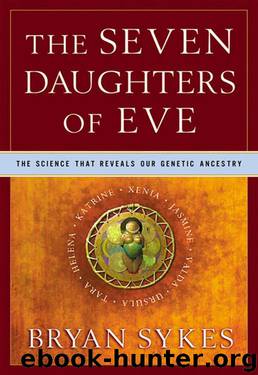The Seven Daughters of Eve: The Science That Reveals Our Genetic Ancestry by Bryan Sykes

Author:Bryan Sykes [Sykes, Bryan]
Language: eng
Format: epub, mobi
Tags: Genetics & Genomics, Life Sciences, Social Science, Science, Evolution, Anthropology, Physical
ISBN: 9780393079807
Google: mbwte1cBQOIC
Amazon: 0393323145
Publisher: W. W. Norton & Company
Published: 2002-05-16T22:00:00+00:00
12
CHEDDAR MAN SPEAKS
Although our scientific reasoning now appeared to be watertight, I was still nervous that there might be a flaw in our version of European prehistory that even our most persistent and vociferous critics had overlooked. They had done a good job in making us test and prove every conceivable aspect of our principal tool – mitochondrial DNA itself. We had checked and rechecked the mutation rate. We had spent weeks running different versions of our evolutionary network programs and they all gave the same results. We had ridden the storm of recombination. We still felt sure that main chapters of the genetic history of Europe were written in the time of the hunter–gatherers, long before the farmers arrived. To be sure, agriculture had added some important extra paragraphs; but it had definitely not erased the original text. We felt very confident that most living native Europeans traced their maternal ancestry back to the hunter–gatherers who lived before the dawn of the Neolithic and the coming of agriculture.
Nevertheless, even though we were very sure of our data and the way we had interpreted them, our conclusions were still only inferences about past events: inferences built on large amounts of data and robust statistical treatments, but inferences none the less. So I was still slightly anxious. Perhaps we had made a mistake about the dates. I didn’t think we had, but suppose we were out by a factor of two? Suppose that events we had dated to fifty thousand years ago actually took place only twenty-five thousand years ago? More importantly, suppose the dates for the major mitochondrial clusters which we had placed at or around the end of the last Ice Age, between fifteen and twenty thousand years ago, were out by the same factor and were really less than ten thousand years old? That would bring them too close for comfort to the Neolithic period, and mean that they might have been part of the wave of Near Eastern farmers after all.
What we needed was a direct test on DNA taken from a human fossil which was known to predate the arrival of farming. If we could only find DNA that fitted into one of these crucial clusters in the remains of a hunter who lived thousands of years before farming was ever thought of, then we would be home and dry. We would not need to rely exclusively on reconstructions from the modern sequences. We would have found the real thing in Palaeolithic Europe. These mitochondrial clusters then had to have arrived in Europe thousands of years before farming ever reached it, and our dates must be right. Conversely, if the DNA from a very old fossil was unlike anything we now found in Europe then we were on shaky ground. We could not then be sure that the ancestors of the major modern clusters were in Europe before farming.
Human remains from the Upper Palaeolithic are few and far between. For one thing, ten thousand years is a very long time, and only in the very best of circumstances do bones last that long.
Download
The Seven Daughters of Eve: The Science That Reveals Our Genetic Ancestry by Bryan Sykes.mobi
This site does not store any files on its server. We only index and link to content provided by other sites. Please contact the content providers to delete copyright contents if any and email us, we'll remove relevant links or contents immediately.
Born to Run: by Christopher McDougall(7064)
The Leavers by Lisa Ko(6910)
iGen by Jean M. Twenge(5366)
Sapiens by Yuval Noah Harari(5293)
The Kite Runner by Khaled Hosseini(5082)
Spare by Prince Harry The Duke of Sussex(5072)
Machine Learning at Scale with H2O by Gregory Keys | David Whiting(4172)
Bullshit Jobs by David Graeber(4094)
Never by Ken Follett(3788)
Goodbye Paradise(3726)
Livewired by David Eagleman(3682)
Fairy Tale by Stephen King(3216)
A Dictionary of Sociology by Unknown(3026)
Harry Potter 4 - Harry Potter and The Goblet of Fire by J.K.Rowling(2987)
The Social Psychology of Inequality by Unknown(2937)
The Club by A.L. Brooks(2862)
Will by Will Smith(2790)
0041152001443424520 .pdf by Unknown(2784)
People of the Earth: An Introduction to World Prehistory by Dr. Brian Fagan & Nadia Durrani(2701)
